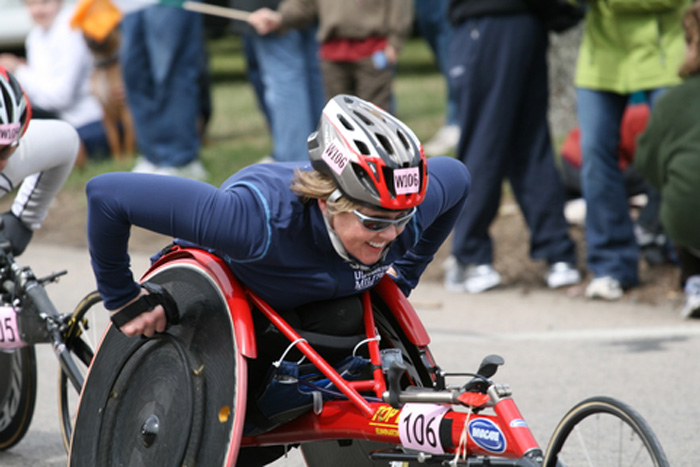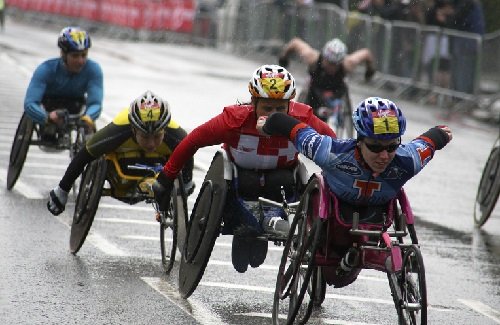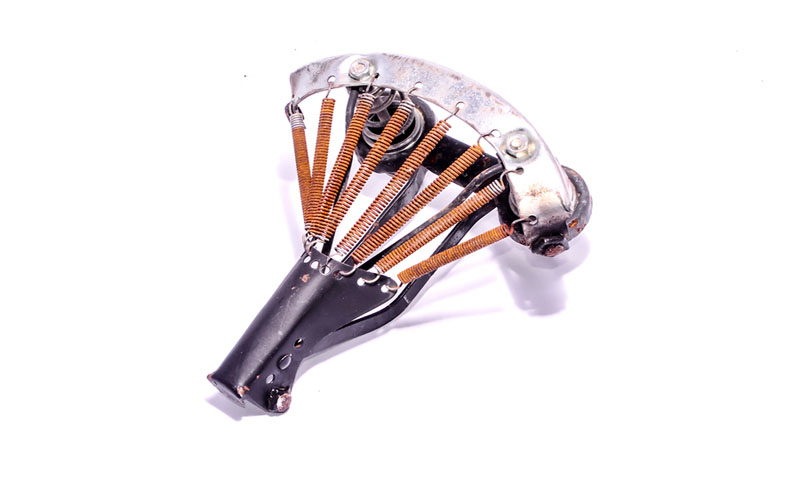How to Measure Heart Rate Recovery &
Average Resting Heart Rate
by Bonnie Gabaldon
 Dawna Callahan Races Her Wheelchair
Dawna Callahan Races Her Wheelchair
Why is Heart Rate Important?
Knowing how to measure heart rate recovery and resting rates is an excellent way to monitor your heart health and progress towards greater fitness. This is true whether you are newly embarking on a fitness lifestyle, or have been physically active for some time.
The number one cause of death in the United States, cardiovascular disease, is preventable. Regular cardio/aerobic exercise improves your heart health.
A strong, healthy heart is a more efficient heart that pumps a greater volume of blood with less effort for every beat per minute (BPM).
The opposite is also true. A weak, unhealthy heart must work harder and pump faster to deliver the same amount of blood.
Check out Peloton Bikes and Equipment at Amazon
Two Measurements of Heart Health
Recovery rate is the speed at which your heart rate returns to normal two minutes after exercise ceases. It is a measure of your cardiovascular condition. The faster your heart rate returns to normal, the stronger your lungs and heart.
It measures the peak rate during exercise as compared to the moment exercise ceases. A normal recovery decrease is at least 12 beats in 1 minute and about 20 beats in 2 minutes.
According to the New England Journal of Medicine, a longer heart-rate-recovery time increases the risk of death more than a shorter recovery time – regardless of physical condition or other risk factors.
If you prefer, you can have your recovery rate determined by a stress test -- something your doctor can order.
Resting heart rate is the number of times your heart beats per minute when you are at rest. By including cardio/aerobic exercise on a regular basis, you will see a reduction in your resting heart rate as your heart becomes stronger and expends less effort pumping more blood per heartbeat. If the heart is weak, it has to beat faster to pump the same amount of blood as a healthy heart.
The best time to check resting heart rate is first thing in the morning before you get out of bed. Resting heart rate speaks volumes about your state of fitness, and the more fit you become, the rate will decrease because your heart is more efficient.
Merach Recumbent Stationary Exercise Bikes With Blue Tooth
Great for Rehabilitation and Physical Therapy
Available upgrades include: padded seat with ergonomic backrest, car-style gear shifter, and heartrate tracking
How to Measure Heart Rate Recovery
Both heart rate recovery and resting heart rate numbers can be monitored using a fitness tracker or heart-rate monitor.
You can determine your target heart rate zone as follows.
First, subtract your age from 220 to determine your estimated maximum heart rate; then, 60%-80% of your maximum heart rate. This is your target zone.
You can monitor your rates with a heart-rate monitor. For information on how to do this without a heart-rate monitor, follow the link to Cardio Endurance below.
Second, begin an aerobic workout until you reach your target heart rate. Stop exercising, and immediately check your heart rate. Take long, deep breaths and relax your body. Check your heart rate again in two minutes. Subtract the second number from the first. The difference between the two numbers is the beats-per-minute (bpm) that your heart has recovered.
The difference between the numbers is an indicator of your fitness level:
-- less than 22, your biological age is older than your calendar age.
-- 22-52, your biological age is about the same as your calendar age.
-- 53-53, your biological age is slightly younger than your calendar age.
-- 59-65, your biological age is moderately younger than your calendar age.
-- 66 +, your biological age is much younger than your calendar age. You rock!
Heart rate monitors are also a great way to measure your heart rate. Although some fitness trackers aren't as accurate as medical devices, they're accurate enough for most consumers' basic fitness data needs.
Factors That May Affect Heart Recovery Rate
Factors that may affect heart rate recovery include: caffeine consumption, hydration, and gender. Men's heart rates are typically slower than women's.
Check out the great selection of SPORTS WATCHES on Amazon
More Topics That May Interest You
We have all used the expression to describe someone as having a "big heart." Not to be Debbie Downer here; but, the truth is that an enlarged heart is a heart that has been working too hard. A smaller heart is an efficient, healthy heart.
Music For Exercise and Workouts at Amazon

Writer/attorney, Bonnie Gabaldon, is the owner/developer of the health & fitness website, BodiesOfEvidence.com.
Bonnie graduated summa cum laude from Oregon State University with honors. She is a member of Beta Beta Beta Biological Honor Society and Phi Kappa Phi Honor Society.
She researched and authored a significant undergraduate independent study paper, The Effect of Female Hormones on Elite Female Athletes During the First Trimester of Pregnancy.
Bonnie attended the University of New Mexico School of Law and Georgetown Law Center, and has been a licensed attorney since 2003.
Some of the advertisers on my website are affiliate partners, which means that I may receive a small commission from any sale, at no extra cost to you.
For example, the Amazon affiliate advertising program is designed to provide a means for sites to earn fees by advertising and linking to amazon.com.
Your tips and purchases help to support this free-information website.
Thank you.
The content of this website is for informational purposes only and not intended to be taken as a replacement for professional medical advice, care, diagnosis or treatment by a doctor, dietitian, physical therapist, nutritionist or fitness instructor.
DO NOT BEGIN ANY EXERCISE PROGRAM WITHOUT CHECKING WITH YOUR DOCTOR FOR UNDERLYING CONDITIONS THAT MAY PREVENT YOU FROM DOING SO.






